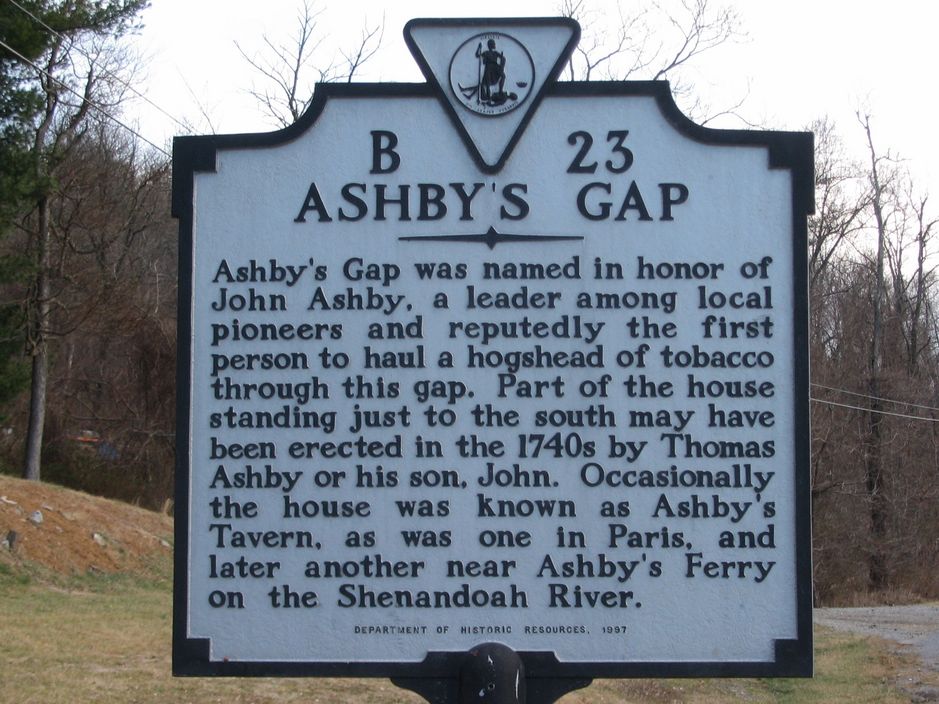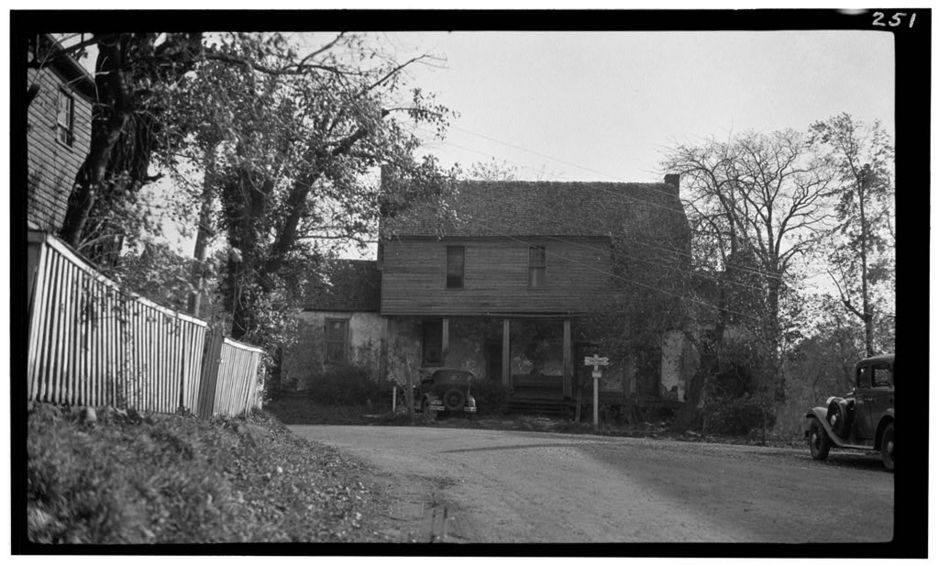CAPT. JACK ASHBY;
JOY TO HIS MEMORY
---------------------------------
A Famous Mountain Pass Bears His Name.
-----------------------------------------------------------
STUFF THAT MADE AMERICA
-----------------------------------------------------------
An Indian Fighter, an Intrepid Scout and All Around Brave Man -- His Hair-Breadth Escape; Treasured History in the Valley.
JOY TO HIS MEMORY
---------------------------------
A Famous Mountain Pass Bears His Name.
-----------------------------------------------------------
STUFF THAT MADE AMERICA
-----------------------------------------------------------
An Indian Fighter, an Intrepid Scout and All Around Brave Man -- His Hair-Breadth Escape; Treasured History in the Valley.
(Special Dispatch to The Times.)
Berryville, VA. Dec 13.--There is perhaps no point in that section of the Blue Ridge Mountains in the Valley of Virginia so well known as Ashby's Gap. In the course of a year, thousands of people descend the mountain at this particular point, yet there are very few who know how it got it's name. It is common belief that it was associated with some of the daring deeds of that knightly soldier, Gen. Turner Ashby, but such is not the case. Here is the story, with a few incidents, of how it came about:
Jack Ashby, who was raised in Stafford, or that part of Prince William now known as Fauquier county, drove a team of horses engaged in hauling produce from the Valley many years ago.
The "bent" of the Blue Ridge at Paris was very precipitous and wagons could not descend safely without being "locked" and then "logged" by attaching a tree to the hind part of the vehicle. Ashby, young and ardent, would stand no such logging and delay. When he got to the top of the ridge, he said that "it was a sorry team that couldn't outrun the wagon," and dashed down the gorge with two huge hogsheads of tobacco.
The wagon was propelled with such force that the tobacco burst through the front gate, killed one or two horses and wreaked the entire outfit. Ashby, bruised and battered after a while emerged from the wreck, looking as if he had had an encounter with a Shawnee Indian. This feat distinguished him, and gave a name to the "bent" by which it is known today on all the maps of Virginia as Ashby's Gap.
INDIAN TROUBLES
After the gap was named, the Indians began to give trouble to the whites about the Shawnee Springs and Fort Loudoun, at Winchester. Ashby then became a ranger. His business was to curb the Indians, and he was personally known to many of them. After hostilities began he was sauntering around the fort and a small party of red-skins came upon his trial, and were very near killing or capturing him. He retreated with great speed, and they followed, throwing missles and firing at him. He outran all, except one. The other Indians quit the chase and exclaimed "Run Ashby! Run Ashby!" They wanted him to escape, because they had failed to get him. The near Indian threw his tomahawk at Ashby just as he mounted the stockade at the fort, and the weapon struck by the side of Ashby without doing him harm. Ashby--safe, self-possessed, and witty--hallowed back to the savage: "Blast your eyes; at such a time do you think I would run booty?" After that he walked into the fort in triumph.
General Braddock, in 1775 was defeated by the Indians and French. It created consternation and alarm in the valley and the commander at Fort Loudoun sent a dispatch to Governor Dinwiddle informing him of the disaster. Ashby was the courier and he made the trip to Williamsburg and back to Winchester in less than three days. The commander upon seeing Ashby at the fort after he had given the dispatch, asked him why he had not started for Williamsburg. He answered that he had been there and to prove it presented the Governor's reply. The distance traveled was about four hundred miles.
Captain John (Jack) Ashby died about 1802 and left a reputation long treasured in this country. General Turner Ashby, the valiant Confederate cavalry leader was a relative of this strenuous man.
TheTimes, Richmond,VA Sunday December 14, 1902
Berryville, VA. Dec 13.--There is perhaps no point in that section of the Blue Ridge Mountains in the Valley of Virginia so well known as Ashby's Gap. In the course of a year, thousands of people descend the mountain at this particular point, yet there are very few who know how it got it's name. It is common belief that it was associated with some of the daring deeds of that knightly soldier, Gen. Turner Ashby, but such is not the case. Here is the story, with a few incidents, of how it came about:
Jack Ashby, who was raised in Stafford, or that part of Prince William now known as Fauquier county, drove a team of horses engaged in hauling produce from the Valley many years ago.
The "bent" of the Blue Ridge at Paris was very precipitous and wagons could not descend safely without being "locked" and then "logged" by attaching a tree to the hind part of the vehicle. Ashby, young and ardent, would stand no such logging and delay. When he got to the top of the ridge, he said that "it was a sorry team that couldn't outrun the wagon," and dashed down the gorge with two huge hogsheads of tobacco.
The wagon was propelled with such force that the tobacco burst through the front gate, killed one or two horses and wreaked the entire outfit. Ashby, bruised and battered after a while emerged from the wreck, looking as if he had had an encounter with a Shawnee Indian. This feat distinguished him, and gave a name to the "bent" by which it is known today on all the maps of Virginia as Ashby's Gap.
INDIAN TROUBLES
After the gap was named, the Indians began to give trouble to the whites about the Shawnee Springs and Fort Loudoun, at Winchester. Ashby then became a ranger. His business was to curb the Indians, and he was personally known to many of them. After hostilities began he was sauntering around the fort and a small party of red-skins came upon his trial, and were very near killing or capturing him. He retreated with great speed, and they followed, throwing missles and firing at him. He outran all, except one. The other Indians quit the chase and exclaimed "Run Ashby! Run Ashby!" They wanted him to escape, because they had failed to get him. The near Indian threw his tomahawk at Ashby just as he mounted the stockade at the fort, and the weapon struck by the side of Ashby without doing him harm. Ashby--safe, self-possessed, and witty--hallowed back to the savage: "Blast your eyes; at such a time do you think I would run booty?" After that he walked into the fort in triumph.
General Braddock, in 1775 was defeated by the Indians and French. It created consternation and alarm in the valley and the commander at Fort Loudoun sent a dispatch to Governor Dinwiddle informing him of the disaster. Ashby was the courier and he made the trip to Williamsburg and back to Winchester in less than three days. The commander upon seeing Ashby at the fort after he had given the dispatch, asked him why he had not started for Williamsburg. He answered that he had been there and to prove it presented the Governor's reply. The distance traveled was about four hundred miles.
Captain John (Jack) Ashby died about 1802 and left a reputation long treasured in this country. General Turner Ashby, the valiant Confederate cavalry leader was a relative of this strenuous man.
TheTimes, Richmond,VA Sunday December 14, 1902

Ashby's Tavern was a landmark in Paris for more than 150 years. The eight room, half stone, half wooden structure was built in 1775 and was bought by Capt. Thomas Ashby shortly after the War of 1812.
It was the social center of Paris and stood as both a drinking establishment and a private residence until the late 1930s. It was then that the tavern was done in by old Rt. 50 which rumbled down a perilously steep hill through the hamlet to a junction with Rt. 17.
One night a flatbed truck laden with bricks made a rapid descent of the hill without the benefit of brakes. As it hurtled down Main Street, the man on the passenger side of the truck jumped out. However, the driver stayed with with his crippled vehicle as it broadsided the tavern at the end of the street. Both the driver of the truck and the tavern were fatalities of the crash.
Today an abandoned gas station and an abandoned motor court mark the spot where Ashby's Tavern once stood.
(The Winchester Star, January 14, 1981) (As of 2013 an antiques store sits where the tavern once stood)
Poplar Tree at Ashby's Gap
Another landmark that has gone to its reward is the poplar tree that stood on the mountain at the head of Ashby's Gap.
It was used as a landmark from the time when Indians wandered the area. Jackson made reference to the tree in a letter to his wife and a good deal of local lore sprang up around it.
The tree was supposedly so big that four men could play cards in its hollow. The poplar tree stood at the corner of Fauquier, Clarke, Warren and Loudoun counties at a spot called "Poplar Corner," It was said a man could escape from law enforcement officials in one county simply by running around the tree and out of the jurisdiction of the county in which he was being chased.
The tree was a favorite spot for lover's meetings, and weathered several direct hits from lighting bolts. It did not however, weather the efforts of two "coon hunters" to capture their prey in 1909. The hunters set fire to the tree in order to smoke the racoon out from the upper branches and in the process the tree burned down to skeletal form.
It remained that way until 1923 when it was cut down for the building of Route 50.
(The Winchester Star, January 14, 1981)
Another landmark that has gone to its reward is the poplar tree that stood on the mountain at the head of Ashby's Gap.
It was used as a landmark from the time when Indians wandered the area. Jackson made reference to the tree in a letter to his wife and a good deal of local lore sprang up around it.
The tree was supposedly so big that four men could play cards in its hollow. The poplar tree stood at the corner of Fauquier, Clarke, Warren and Loudoun counties at a spot called "Poplar Corner," It was said a man could escape from law enforcement officials in one county simply by running around the tree and out of the jurisdiction of the county in which he was being chased.
The tree was a favorite spot for lover's meetings, and weathered several direct hits from lighting bolts. It did not however, weather the efforts of two "coon hunters" to capture their prey in 1909. The hunters set fire to the tree in order to smoke the racoon out from the upper branches and in the process the tree burned down to skeletal form.
It remained that way until 1923 when it was cut down for the building of Route 50.
(The Winchester Star, January 14, 1981)

Ashby's Gap

Ashby's Tavern Destroyed in the 1930s